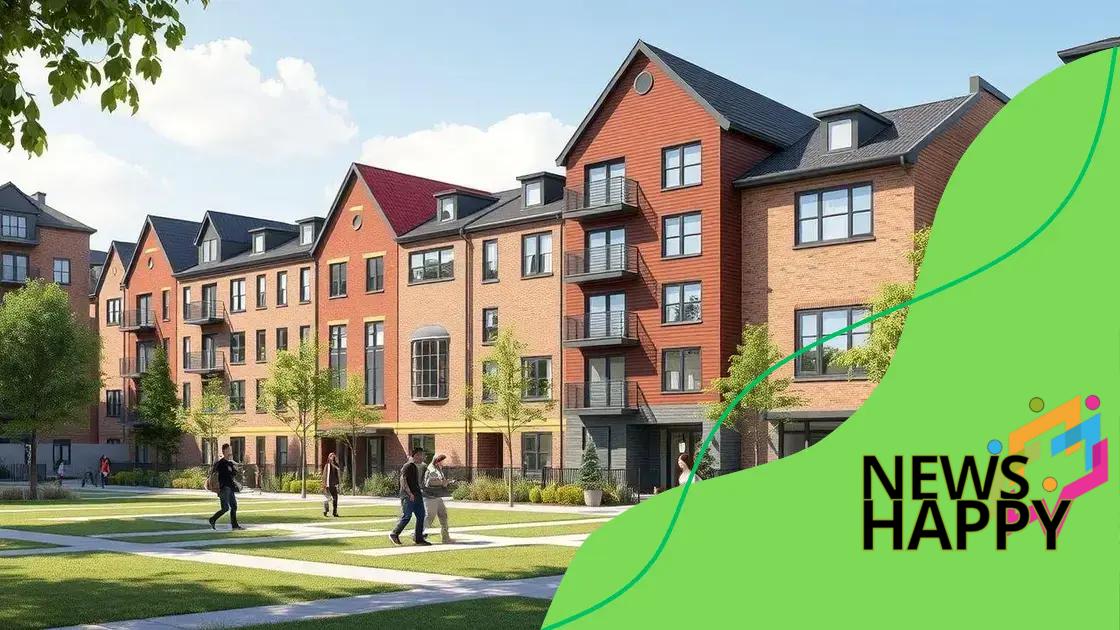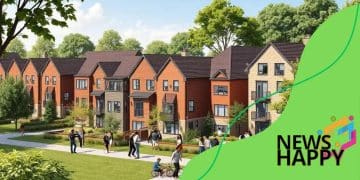Expanding access to affordable housing under new federal policies

Anúncios
Expanding access to affordable housing under new federal policies focuses on innovative financing models, increased community involvement, and addressing implementation challenges to ensure stable living conditions for low-income families.
Expanding access to affordable housing under new federal policies is more than just a goal; it’s a pathway to stability for countless families. Have you ever wondered how these changes could affect you or your community? Let’s dive in.
Anúncios
Understanding the new federal policies
Understanding the new federal policies can seem daunting, but it’s essential for grasping how affordable housing is evolving. These changes aim to provide clearer pathways for housing solutions.
Key Aspects of the New Policies
The new federal policies focus on increasing access to safe and affordable housing for everyone. Here are some vital components:
- Increased funding for low-income housing
- Streamlined approval processes for housing projects
- Support for first-time home buyers
- Enhanced protections against eviction
By examining these elements, we can see a shift in priorities. The government is trying to connect families with resources needed to thrive. For example, the increased funding helps local authorities to tackle housing shortages effectively.
Anúncios
Impact on Communities
These policies aim not only to support individuals but also to strengthen communities. Affordable housing fosters stability, which leads to healthier neighborhoods. When families have access to quality housing, it affects their overall well-being and opportunity.
Moreover, better housing policies reduce homelessness rates. Families are less likely to face crisis situations when they have stable homes. This, in turn, allows children to succeed in school and adults to maintain steady jobs. Stronger communities create more vibrant local economies, and that benefits everyone.
On the other hand, understanding the implications of these policies means staying informed. Local workshops and community meetings are excellent ways to learn more and ask questions. Engaging with local leaders can help clarify how these policies will impact your neighborhood.
The impact on low-income families
The impact of new federal policies on low-income families is profound. For many, these changes offer hope and opportunity when it comes to securing affordable housing.
Access to Resources
With increased funding and support, families can find more accessible housing options. This is crucial in areas where the cost of living is high. Better access to resources means families can focus more on their daily lives rather than struggling just to keep a roof over their heads.
- Financial assistance for housing costs
- Subsidies for utilities and maintenance
- Programs for first-time homebuyers
- Repair assistance for existing homes
Such programs aim to relieve the financial burden that low-income families often face. It is essential to recognize that housing stability directly impacts children’s education and overall family health. Stable living conditions allow for more productive family environments.
Educational Opportunities
Moreover, when families have secure housing, children can attend school regularly. This stability often leads to improved educational outcomes. Schools in stable neighborhoods tend to provide better resources. For low-income families, this is a significant aspect of breaking the cycle of poverty.
In addition, these policies help to create a sense of community. Families who feel secure in their homes are more likely to get involved in local events and community initiatives. This engagement fosters a sense of belonging and collective responsibility, which benefits everyone in the area.
Despite these positive impacts, challenges still exist. Some families may struggle with navigating the application process for assistance programs. It’s important for local organizations to provide guidance and support, ensuring that families can take advantage of available resources.
Innovative approaches to affordable housing

Innovative approaches to affordable housing are essential to meet the rising demand for homes. As urban areas grow, traditional methods of housing development are no longer sufficient. By exploring new strategies, we can create sustainable solutions for all.
Public-Private Partnerships
One key innovation is the idea of public-private partnerships. These collaborations bring together government resources and private sector efficiency. When both sectors work together, they can build more affordable housing units quickly. This approach leverages the strengths of each sector to create better outcomes for communities.
- Increased funding from private investors
- Shared risk and reward
- Faster project completion
- Greater innovation in design and construction
By pooling resources and knowledge, public-private partnerships streamline the development process. As a result, cities can see faster improvements in housing availability.
Adaptive Reuse of Buildings
Another innovative method is the adaptive reuse of existing structures. Rather than building new homes from scratch, developers are repurposing old warehouses and factories. This strategy not only saves time and materials but also revitalizes neighborhoods. Using existing buildings to create affordable housing helps maintain the character of communities while providing new living spaces.
Adaptive reuse projects often come with unique designs that appeal to diverse populations. For example, converting an old school into apartments can provide spacious units with historical charm. This approach helps to create affordable housing options without contributing to urban sprawl.
Moreover, sustainable practices play a significant role in these innovations. Many new affordable housing projects focus on eco-friendly building materials and energy-efficient designs. These sustainable elements not only reduce utility costs for residents but also contribute to a healthier planet. Innovations like solar panels, green roofs, and energy-efficient appliances are becoming common in modern affordable housing developments.
Challenges facing implementation
Challenges facing implementation of new federal policies for affordable housing are significant. While the intention is to create better living conditions, several issues can hinder progress.
Funding Limitations
One of the main challenges is the availability of funding. Although new policies often come with promises of financial support, budgets can be tight. Limited resources make it tough for local governments to execute projects efficiently. Insufficient funding leads to delays and scaled-back initiatives, ultimately affecting what families can access.
- Rigid budget constraints
- Economic fluctuations impacting available funds
- Inconsistent commitment from funding sources
- Difficulty in securing private investments
The uncertainty around funding raises concerns for many stakeholders involved in affordable housing projects. Developers may hesitate to invest time and resources without assurance of financial backing.
Bureaucratic Obstacles
In addition to funding challenges, bureaucratic obstacles can slow down the implementation process. Often, multiple approvals are required for a single project. This includes zoning, permits, and various inspections. Navigating through red tape can take months or even years, leaving families waiting for housing solutions.
Streamlining processes is essential, yet it requires coordination across different government departments. When agencies collaborate effectively, construction can begin sooner, leading to faster access to affordable housing.
Moreover, community opposition can also present challenges. People sometimes resist new projects fearing changes to their neighborhoods. Engaging with the community early on is vital. Educating residents on the benefits of affordable housing can help gain support and ease concerns.
The dynamic landscape of the housing market adds another layer of complexity. Rapidly changing trends can affect local needs and priorities. For affordable housing initiatives to succeed, they must be adaptable to these shifting conditions.
Future prospects for affordable housing initiatives
Future prospects for affordable housing initiatives look promising yet complex. As awareness of the housing crisis grows, communities are seeking effective solutions to enhance access to affordable housing.
Innovative Financing Models
One key aspect of the future is the development of innovative financing models. These new approaches aim to provide better support for affordable housing projects. For instance, community land trusts allow residents to collectively own land, ensuring long-term affordability. This system helps balance housing needs while preserving community interests.
- Social impact investing to fund affordable housing
- Expansion of tax incentives for developers
- Crowdfunding for community projects
- Public-private partnerships for sustainable financing
Such models can pave the way for more affordable units to be built. As cities recognize the value of sustainable development, collaboration between various stakeholders becomes essential.
Stronger Community Involvement
Another important prospect is the increased involvement of local communities. Engaging residents in the planning process leads to better outcomes. When communities voice their needs, it creates stronger, more effective programs.
Additionally, educational campaigns help to raise awareness about housing issues. Communities that understand the importance of affordable housing are more likely to advocate for meaningful change. This includes pushing for local policies that support affordable housing development.
Technology also plays a role in shaping the future of affordable housing. Online platforms can streamline resources, making it easier for families to access assistance. Moreover, data-driven solutions can help identify areas most in need of affordable housing, ensuring resources are allocated effectively.
As federal policies evolve, flexibility and adaptability will be crucial. Addressing the challenges of the present while preparing for the future requires ongoing collaboration and innovation. The vision for affordable housing must include diverse, sustainable options that benefit everyone.
FAQ – Frequently Asked Questions about Affordable Housing Initiatives
What are the key goals of new federal policies for affordable housing?
The key goals include increasing access to safe and affordable housing, providing stable living conditions for families, and improving community development.
How do public-private partnerships benefit affordable housing projects?
Public-private partnerships leverage resources from both sectors, helping to accelerate project completion and reduce costs, ultimately leading to more housing units being built.
What challenges are communities facing in implementing affordable housing?
Challenges include funding limitations, bureaucratic obstacles, community opposition, and the need for timely execution of housing projects.
How can community involvement impact affordable housing initiatives?
Community involvement ensures that local needs and preferences are considered, leading to more effective and adopted housing solutions that truly benefit residents.





